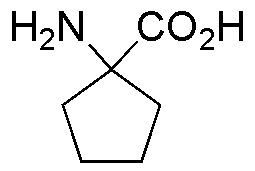Cycloleucine is widely utilized in research focused on
- Neuroscience: It serves as an important tool for studying neurotransmitter systems, particularly in understanding the role of amino acids in brain function.
- Pharmaceutical Development: Cycloleucine is used in drug formulation research, especially for developing compounds that target specific receptors, enhancing therapeutic efficacy.
- Protein Synthesis Studies: Researchers utilize it to investigate the effects of amino acid analogs on protein synthesis, providing insights into metabolic pathways.
- Biochemical Research: It acts as an inhibitor in various enzymatic reactions, allowing scientists to explore enzyme mechanisms and potential inhibitors for therapeutic applications.
- Plant Biology: Cycloleucine is applied in studies of plant growth regulation, helping to understand how amino acid analogs affect plant development and metabolism.
General Information
Properties
Safety and Regulations
Applications
Cycloleucine is widely utilized in research focused on
- Neuroscience: It serves as an important tool for studying neurotransmitter systems, particularly in understanding the role of amino acids in brain function.
- Pharmaceutical Development: Cycloleucine is used in drug formulation research, especially for developing compounds that target specific receptors, enhancing therapeutic efficacy.
- Protein Synthesis Studies: Researchers utilize it to investigate the effects of amino acid analogs on protein synthesis, providing insights into metabolic pathways.
- Biochemical Research: It acts as an inhibitor in various enzymatic reactions, allowing scientists to explore enzyme mechanisms and potential inhibitors for therapeutic applications.
- Plant Biology: Cycloleucine is applied in studies of plant growth regulation, helping to understand how amino acid analogs affect plant development and metabolism.
Documents
Safety Data Sheets (SDS)
The SDS provides comprehensive safety information on handling, storage, and disposal of the product.
Product Specification (PS)
The PS provides a comprehensive breakdown of the product’s properties, including chemical composition, physical state, purity, and storage requirements. It also details acceptable quality ranges and the product's intended applications.
Certificates of Analysis (COA)
Search for Certificates of Analysis (COA) by entering the products Lot Number. Lot and Batch Numbers can be found on a product’s label following the words ‘Lot’ or ‘Batch’.
*Catalog Number
*Lot Number
Certificates Of Origin (COO)
This COO confirms the country where the product was manufactured, and also details the materials and components used in it and whether it is derived from natural, synthetic, or other specific sources. This certificate may be required for customs, trade, and regulatory compliance.
*Catalog Number
*Lot Number
Safety Data Sheets (SDS)
The SDS provides comprehensive safety information on handling, storage, and disposal of the product.
DownloadProduct Specification (PS)
The PS provides a comprehensive breakdown of the product’s properties, including chemical composition, physical state, purity, and storage requirements. It also details acceptable quality ranges and the product's intended applications.
DownloadCertificates of Analysis (COA)
Search for Certificates of Analysis (COA) by entering the products Lot Number. Lot and Batch Numbers can be found on a product’s label following the words ‘Lot’ or ‘Batch’.
*Catalog Number
*Lot Number
Certificates Of Origin (COO)
This COO confirms the country where the product was manufactured, and also details the materials and components used in it and whether it is derived from natural, synthetic, or other specific sources. This certificate may be required for customs, trade, and regulatory compliance.


